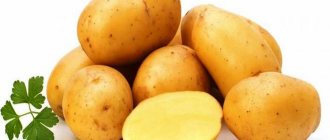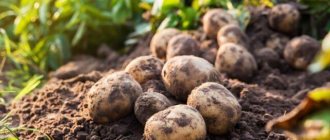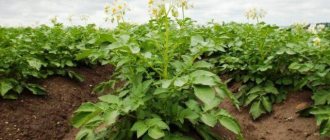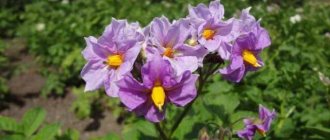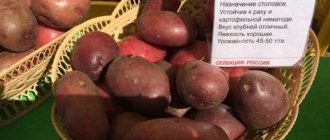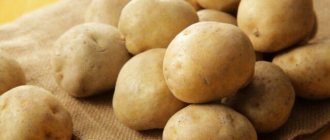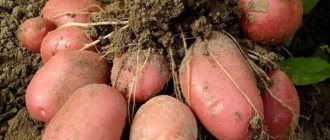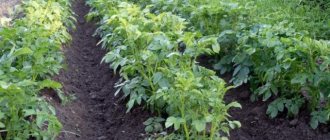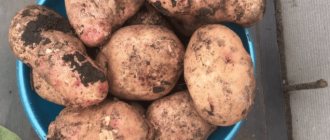History of origin
The Nandina potato was bred about ten years ago by breeders of a very famous agricultural company from Germany, EuroPlant Pflanzenzucht GMBH (or, for short, simply “EuroPlant”). An application for its registration in the Russian Federation was submitted in 2012, and the necessary variety tests were completed quite quickly. Since 2015, it has been listed in the domestic State Register of Selection Achievements.
Elite seed potatoes are one of the main “specializations” of the originator of the Nandina variety
Description of Nandina potato variety
The appearance of Nandina potato bushes is typical for the crop. A layman will definitely not be able to distinguish them from other varieties and hybrids. The tubers look quite presentable, which undoubtedly attracts the attention of amateur gardeners and farmers when choosing a variety.
Bush
The bushes reach 55-60 cm in height. The root system is well developed, the stems are quite powerful, semi-erect. The leaves are large, their type varies from completely open to intermediate, the shade - from light, almost salad, to rich green. Medium-sized flowers with pale lilac petals
Nandina potato bushes rarely “fall apart”
Tubers
The tubers have a regular round-oval shape. Their weight is 72-132 g, “trifles”, unsuitable for storage and inconvenient for cleaning, are practically absent from the “nests”.
The skin of the tubers is yellowish-beige, thin, but quite durable. This ensures good shelf life and transportability. Most of the “eyes” are small and superficial, but there are also slightly recessed ones. The pulp is creamy-yellow, elastic, not watery, with a noticeably “oily” consistency, retaining color and shape after heat treatment. The average starch content (12.8-15%) “helps” with this.
The percentage of marketable tubers is 77-93%
The best mid-early varieties
On average, you can get an excellent harvest of mid-early potatoes on the 70th day. Such varieties are highly resistant to infections, except for late blight. They have excellent commercial qualities, so they can be grown for sale.
Gala
This table variety was bred by German breeders and is grown in many regions of Russia. Allows you to obtain a high-quality harvest in almost any soil and climatic conditions, but it is necessary to carry out all agrotechnical measures correctly.
Gala has the following characteristics:
- on average the yield is 250 centners per hectare, but up to 420 centners can be harvested;
- the bushes grow of medium length, the leaves are large, and the flowering is weak (the corollas are white);
- tuber weight – 80-130 g, shape – round, smooth;
- the skin is yellowish with shallow eyes, and the color of the pulp can vary from light yellow to dark yellow;
- tubers are well suited for mechanical cleaning, do not darken or become soft;
- low starch content - 11-13%, therefore often included in the diet;
- commercial quality is up to 96%, so potatoes can be stored and transported for a long time.
The plant is well resistant to scab, but is often affected by late blight and rhizoctonia.
It is recommended to completely remove the tops 14 days before harvest to extend the shelf life of the potatoes in good condition.
Red Scarlet
It is one of the most popular red-skinned table potatoes, often grown in the Central and Southern regions. It was bred by Dutch breeders. In addition, the yield is attractive - from 1 hectare you can collect 400-660 centners of tubers. On average, their size ranges from 85 to 120 g. They have an oblong shape, smooth, even skin, small eyes and yellow flesh. They do not change color either due to mechanical damage or after cooking.
Such potatoes are resistant to many diseases. So, he is not afraid of cancer, nematodes, late blight and leaf curl. In addition, the plant develops well in dry summer conditions. A disadvantage can be considered slightly below average resistance to viruses and scab.
Detskoselsky
Refers to productive table varieties with a growing season of 110-115 days. The bush grows of medium height with a colored stem and is well leafy. White corollas appear. In general, the plant blooms profusely, but for a short time.
The tubers themselves are of medium size - from 85 to 120 g. The starch content in them is 12-18%, and the protein content is 1.7-2%. They have light pink smooth skin and a flat oval shape. The flesh is white, but with small eyes. The plant is not afraid of cancer, but can be affected by late blight, common scab and the S virus.
Amorosa
It is also a table variety, which is distinguished by excellent taste and good presentation. Gives the best harvest with optimal moisture levels. Ripe tubers are oval in shape, large in size, red skin and yellow flesh. The level of dry matter in them is 19.5%.
The variety is resistant to Y-virus, leaf curl, and late blight of tubers. As a rule, it is affected by common scab, but late blight of tops is more common.
Marfona
This variety bears fruit with beautiful, uniform tubers that have medium-depth eyes, an oval shape, yellow skin and light yellow flesh that does not soften when cooked. Dry matter level – 18.7%. Tubers are not afraid of mechanical damage and can be stored for a long time.
The plant can develop in conditions of high air and soil temperatures. At the same time, it is resistant to viruses and late blight of tubers. A greater threat is posed by leaf curl and common scab, and an even greater threat is the nematode.
Romano
The variety was bred in the Netherlands. The bushes grow tall and leafy. The flowers are red-violet in color. The stem is straight and moderately colored with anthocyanin. The plant bears fruit with oval tubers weighing 120-180 g, starch content 10.5-13.8%, and protein content from 1.75 to 2.1%. Their skin is pink and the flesh is light cream.
The plant exhibits high resistance to cancer and Y-virus, moderate resistance to leaf curl, and weak resistance to late blight. To get a good harvest, you cannot do without additional processing.
Adretta
This table variety was brought to Russia from Germany. Its characteristics are:
- average yield – 450 centners per 1 ha;
- medium-sized bush with white corollas;
- the tubers are oval in shape and weigh 120-140 g;
- the peel is yellow and there are rare small eyes on it;
- the average starch level is 16%.
The plant is resistant to low temperatures and rot, but can be affected by scab, late blight, blackleg and rhizoctonia.
Like other mid-early varieties, Adretta should not be kept in the soil to prevent the tubers from rotting during heavy autumn rains.
Characteristics of Nandina potatoes
Nandina is an ultra-early table potato. But in order not to make a mistake in choosing a variety for your own personal plot, it is necessary to evaluate not only the timing of crop ripening, but also other important characteristics.
Taste qualities of Nandina potatoes
Taste qualities are officially recognized as “good” and “excellent”. This is not typical for early varieties. According to the culinary classification, it belongs to type AB. Tubers are suitable for boiling, frying, baking, stewing. They can be used to prepare any soups, complex side dishes, and salads.
After heat treatment, Nandina potato pulp retains its characteristic color
Ripening time
It takes 40-45 days for tubers to ripen in central Russia from the moment “mass” shoots appear in the beds. In the southern regions, this period may be reduced by another 5-7 days. In both cases, the variety is naturally classified as ultra-early.
Important! Under optimal conditions, Nandina potatoes practically do not spoil - their keeping quality is 93%.
Productivity
The yield of Nandina potatoes, determined during variety trials conducted in Russia, is 145-320 centners per hectare. This approximately coincides with the performance of the varieties chosen as the standard - Gloria and Bryansk early.
However, the yield varies greatly not only depending on the region of cultivation, it is also influenced by the type of digging that is carried out. The volume of the first “experimental” harvest was 80-180 c/ha: this is significantly (25 c/ha) higher than that of the “standard” variety Zhukovsky early. During the second digging, the indicators of Nandina potatoes are 115-235 c/ha, the “standard” Udacha is 55 c/ha less.
The variety demonstrated record yields (almost 330 c/ha) in the Perm region, surpassing Pushkinets potatoes by 108 c/ha
Important! In one “nest” 8-12 Nandina potato tubers are formed. Accordingly, an amateur gardener can count on 1-1.2 kg per bush.
Growing regions
Officially, Nandina potatoes are recommended for cultivation in the European part of Russia. However, the experience of gardeners who “conducted experiments” in areas with a more severe climate indicates that Nandina potatoes are quite suitable for the Urals, Siberia, and the Far East, if you do not rush into planting. Thanks to the rapid ripening of tubers, gardeners have time to harvest at least one harvest even in a short, cool summer.
Disease resistance
The Nandina variety has “innate” immunity against potato cancer, a bacterial disease for which there are no treatments yet. Plants are not affected by golden cyst nematode. Also in the description of the originator it is mentioned that it is resistant to several types of mosaic and leaf curl viruses. Nandina potatoes are also rarely affected by pathogenic fungi (for example, scab), the only exception being late blight, which affects both the above-ground part of the plant and the tubers.
Tubers affected by late blight are immediately thrown away; they cannot be eaten or stored.
Description of the variety
The Nandina potato is described as a semi-erect plant. The tuber has yellow flesh and skin and is a large semi-oval. Its surface is covered with medium-sized eyes.
The variety was included in the register of the Russian Federation in 2015. The crop is suitable for cultivation in the Central, Volga-Vyatka and North Caucasus regions. Potatoes grown in the northern part of Russia are superior in taste to those in the south. Nandina at the time of ripening contains up to 15% starch in the fruit.
Advantages and disadvantages
The very early ripening of Nandina potatoes allows for two harvests per season. In the southern regions, if the beds are provided with high-quality care, their number generally increases to three.
If you plan to boil or bake Nandina potatoes with their skins on, you can dig them out even slightly unripe
Pros:
- very early ripening;
- the opportunity to get 2-3 harvests per season;
- the yield is quite high for an early variety;
- simple, “basic” planting care;
- the presence of immunity against incurable diseases typical of the culture, a dangerous pest (nematode);
- good transportability;
- a small percentage of potatoes that spoil during harvest storage;
- external presentability of tubers, a minimum of “trifles”;
- good taste;
- culinary versatility.
Minuses:
- the tendency of the above-ground parts of the plant and tubers to be affected by late blight;
- low cold resistance.
Landing Features
Planting Nandina potatoes should never be rushed due to its low cold resistance. Return frosts after planting, if the beds are not covered with black plastic film, will lead to rotting of most of the tubers. And when the temperature drops below -4 °C, they die, despite the shelter. When determining the timing of planting, it is necessary to take into account the long-term weather forecast and measure the soil temperature in advance.
The highest yields of Nandina potatoes are harvested by planting them in well-cultivated soil that combines nutritional value and looseness. Equally important for the rapid ripening of tubers is warmth and sunlight - it is advisable that the bed is located in an open place.
Do not compact the substrate too hard after planting the tubers.
Important! The acid-base balance of the soil in the bed for Nandina potatoes should be close to neutral. In an acidified or alkaline substrate, the root system develops slowly and poorly, which inevitably affects the timing of crop ripening.
The bed is dug up in the fall, adding humus and other fertilizers as needed, getting rid of debris. Nandina potatoes are planted according to the standard scheme, leaving 30-35 cm between adjacent tubers, and 70-75 cm between rows. The depth of the hole is 8-15 cm, depending on the “heaviness” of the substrate. If desired, fertilizers or folk remedies are placed at the bottom to repel pests.
Pre-planting preparation of Nandina potato tubers necessarily includes its germination. Otherwise, the variety ceases to be ultra-early. To prevent late blight, tubers are sprayed with a solution of a suitable fungicide immediately before planting. There are also folk remedies with antifungal properties, they are also suitable.
Germination of planting tubers takes 3-3.5 weeks
Characteristics of the variety
Potato Nandina
Frost resistance
Zorachka Potatoes
Potato Nadina is a plant sensitive to cold. Frosts below -4 Celsius can damage the tops and kill the tubers. During frosts below zero, ice crystals form in the tubers, which destroy the cells. Frozen potatoes will soon begin to rot. Therefore, it is important to plant Nandina after the frost has passed.
Productivity
The yield of the variety is very high - from one hundred square meters you can get up to 330 kilograms of potatoes. Product characteristics – 77-93%. Keeping quality parameters – 93%.
Bloom
The buds of Nandina potatoes correspond to the following description: light red-violet, large. The corolla reaches medium size at the time of flowering. The period of blossoming of buds begins closer to mid-May.
Plant size
The plant reaches medium height, with large leaves on strong tops. The weight of a varietal tuber can reach 70-130 grams, depending on the intensity of watering and the time of harvest.
Care instructions
Nandina potatoes are undemanding in care. Agricultural technology is limited to standard activities:
- Watering. Most often, Nandina potatoes make do with natural precipitation. But if there is no rain for more than ten days, it is hot, and the beds need to be watered. There are also stages of development when bushes especially need water - 7-10 days after the emergence of mass shoots, at the time of bud formation and immediately after flowering.
- Hilling. Nandina potatoes are hilled when the stems reach a height of 12-15 cm and after about two weeks.
- Feeding. If the bed is prepared in accordance with all recommendations, and fertilizers are added to the holes during planting, you can do without fertilizing. Otherwise, 3-4 days after emergence, Nandina potatoes are provided with nitrogen, and complex fertilizer is applied immediately after flowering.
- Disease prevention. The fungus that causes late blight becomes active in rainy, cool weather. To prevent infection, Nandina potato bushes are treated every 7-10 days with a solution of a fungicide suitable for use at this stage of the growing season. Insecticides may also be required to protect against the Colorado potato beetle and other pests. In order to promptly notice their attack on the bushes, it is recommended to inspect the beds weekly.
Hilling is necessary for the proper development of the root system
Important! An optional, but very useful activity is mulching. It allows you to save time on loosening and weeding the beds, and increase the intervals between waterings.
How to care for the variety
For successful cultivation, it is enough to adhere to standard agrotechnical measures:
- Watering mode. Everything here is quite simple: if there is no particular drought, the variety does not require regular watering. If the weather is hot outside, you should water the bushes every 10 days, preferably in the morning and evening hours, to prevent burns of the green mass.
- Systematic loosening of the soil. This measure is necessary to ensure normal air exchange of the root system. In addition, after watering in hot weather, a crust may form on the soil, preventing air circulation; loosening helps to prevent such a situation.
- Weeding in order to get rid of weeds in a timely manner.
- Hilling. The procedure should be repeated twice: as soon as the sprouts stretch to at least 10 centimeters and at the moment of flowering. Hilling up can strengthen the roots, protect against low night temperatures and stimulate tuber formation.
- Competent feeding. During the growth process, potatoes do not particularly need organic matter. A portion of fertilizer applied for autumn digging will be quite enough. Too much nitrogen will provoke excessive growth of green mass, but the fruits will form small. If you notice yellowing of the tops, a month before harvesting the potatoes, the bushes can be treated with a solution of ammonium nitrate and superphosphate diluted in water.
- Don’t forget to mulch the soil, this way the soil will retain moisture much longer and weeds will not grow as actively.
- It is imperative to carry out preventive treatments against late blight, since this disease is a weak point of the variety.
Harvest and storage
The first harvest of Nandina potatoes in the south is harvested in the 20th of June, in central Russia - in the first ten days of July. The last one is at the end of August. The ripening of tubers is “signaled” by drying stems lying on the bed. Both manual and mechanized cleaning are possible.
It is advisable to dig up potatoes when it is sunny and not too hot outside.
Before storing, Nandina potatoes are sorted and dried for 7-10 days. The method and place do not matter; it is more important to provide the tubers with suitable conditions:
- temperature 2-4 °C;
- air humidity 70-80%;
- lack of light and drafts;
- good ventilation.
Important! The approximate shelf life of Nandina potatoes is 2.5-3 months. This is very good for an early variety.
Nandina potatoes are not suitable for long-term storage
